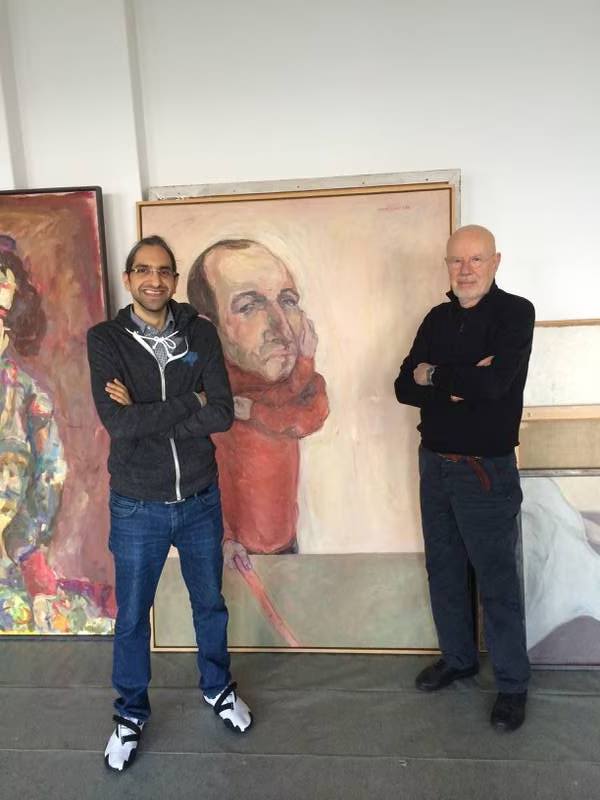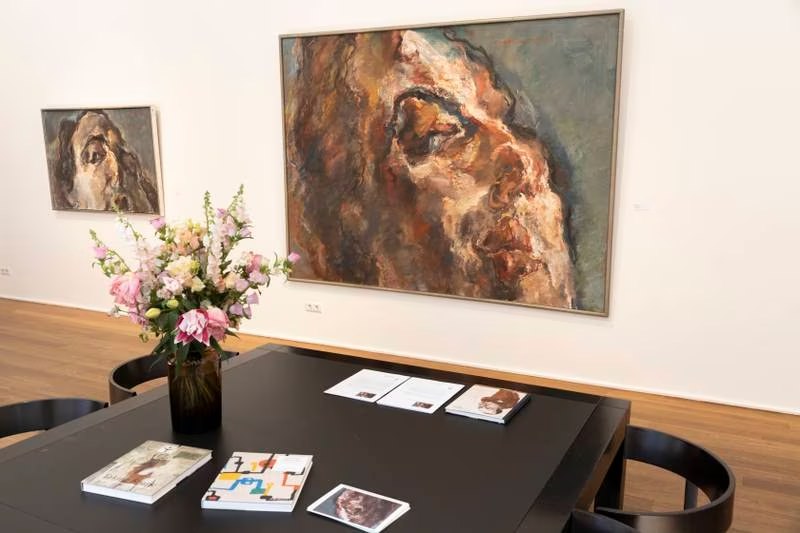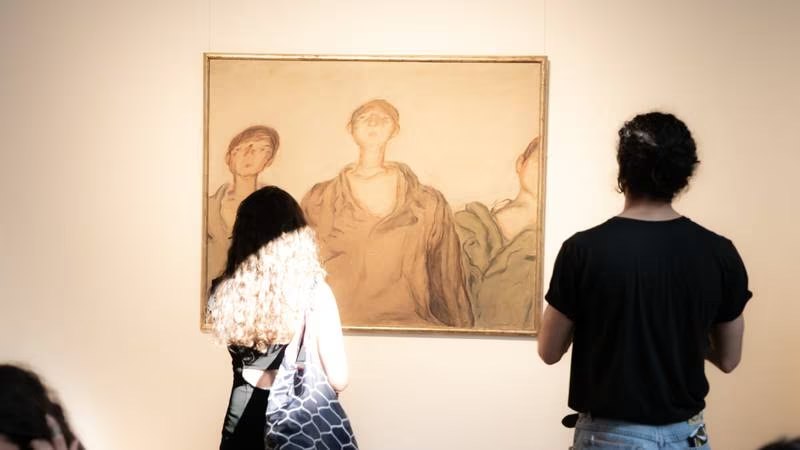Jewels of My Career is organised by the Barjeel Art Foundation and will be running at Lempertz until June 30.
The depth of al ghurba is difficult to measure in English.
The Arabic word at once expresses alienation, cultural isolation, feelings of homesickness as well as yearning, anxiety and loneliness. Throughout his six-decade career, Marwan Kassab-Bachi – the late Syrian artist known as Marwan – sought to capture this multidimensional state in his paintings.
A new exhibition in Berlin brings Marwan’s work back to the city that was at once his home and the crucible of his ghurba. The exhibition is titled The Jewels of My Career. It is organised by the Barjeel Art Foundation and is running at art auction house Lempertz until June 30.
While Marwan left his native Syria in 1957, travelling to Germany where he would live most of his life, he was inextricable from the Arab world. His works have become portraits of the disquiet of living abroad, a yearning for completeness as well as an attachment to a homeland rife with struggle.

Marwan sustained a steady artistic output until his death in 2016. He was the first artist from the Middle East to be accepted to the University of Fine Arts of Hamburg, graduating from its department of painting in 1963.
He worked with a quiet determination for years after, despite measured success. His practice was unencumbered even during the time he worked in a fur factory in Berlin between 1962 and 1970. In fact, he would paint some of his most influential works in that period.
The compounded trials of assimilation and al ghurba – the associated alienation and anxiety – were the foundation of how Marwan depicted many of his subjects. The figures in his paintings often have exaggerated features and project anxiety and loneliness with a rippling vibrancy. The undulating brushstrokes, meanwhile, give his portraits the impression of a landscape, or a perspective between a fugue state and a fever dream.
In The Husband (1966), for instance, a three-armed man wilted by loneliness embraces himself. The man’s features seem to be gradually melting from his face. “The work is about alienation and being in Germany in 1966,” says Sultan Al Qassemi, founder of Barjeel Art Foundation.
His Head series, on the other hand, feature portraits of faces that are distorted across a palette of colours. Through heads and faces, Marwan often leaned towards self-portraiture, projecting himself into his subjects.
Among the most highly-regarded works in the series is a painting created in 1975. It was exhibited during Marwan’s retrospective at the Great Orangery in Charlottenburg, Berlin, in 1976. The exhibition is regarded as a turning point in Marwan’s career, where he was recognised by the German public as an important contributor to the country’s art.

The painting has now returned to Berlin for The Jewels of My Career.
“We have to show these works to the world,” Al Qassemi says. “They have to be seen in the city where he spent the majority of his life, the city he gave so much back to, and the city, which in many cases, was the source of his alienation and artistic thriving. It was where he married and raised a family.”
A significant body of Marwan’s works also have strong political overtones, highlighting issues across the Middle East. In his Study of Three Palestinian Boys (1970), he paints them as towering, defiant figures, albeit gaunt and weary of life under Israeli occupation.
“He depicts the Palestinian boys as giants,” Al Qassemi says. “They are looking down at you, questioning what you’ve done for the Palestinian cause. Even though one of them is being pulled away, the other two are standing their ground.”

Munif Al Razzaz (1965), meanwhile, is a portrait of the former secretary-general of the National Command of the Arab Socialist Baath party. Al Razzaz died in 1984 during his house arrest in Baghdad. During the 1979 Baath purge in Iraq, he was accused of being one of dozens of dissidents plotting against Saddam Hussein, who had recently taken the title of president.
“I remember Marwan insisting on his strong connection to the Arab world despite decades of living in Europe,” Al Qassemi says. “He always said that ‘I come from the Arab world and the Arab world is part of my identity’. He used to write in Arabic. He used to illustrate Arabic books and publications.”
Marwan’s works were highly regarded during his lifetime, having been included in collections ranging from the Centre Georges Pompidou in Paris, the National Museum Damascus, Darat al Funun in Amman, Guggenheim Abu Dhabi and the Museum of Contemporary Art in Chicago.
Join us for the opening of an exhibition of Marwan works from the @BarjeelArt collection in Berlin this Saturday June 10 at 5pm at @Lempertzauction
انضموا لنا في افتتاح معرض مروان في غاليري لامبرتز في برلين Poststraße 22 يوم السبت القادم العاشر من يونيو في تمام الساعه 5:00 م pic.twitter.com/zHtjykX5Lh
— سلطان سعود القاسمي (@SultanAlQassemi) June 5, 2023
After Marwan’s death and the death of curators who were his contemporaries, the artist and his works fell away from the public eye, both in Germany and the Arab world.
The exhibition in Berlin aims to reintroduce Marwan to a generation of new artists and curators and to highlight his legacy as an Arab artist working in the diaspora.
“It is a chance to remind people in Berlin of Marwan,” Al Qassemi says. “Also, a lot of people think of the Syrian and Arab presence in Berlin as something that happened in the last 10 years. In reality, [Arabs] were going there since the 1950s. They came and revitalised the city and not just due to the wave of what was happening in the region.”
The title of the exhibition is taken from a quote Marwan told The National in a 2014 interview. The Barjeel collection, he said, holds “the jewels of my career”.
The quote is both a source of pride and responsibility, Al Qassemi says. The art collector and scholar was good friends with Marwan and regularly visited him at his Berlin studio. He even spoke at his funeral.
“My relationship with Berlin is because of Marwan,” Al Qassemi says. “I used to visit him. I would go to Berlin because Marwan was there. Each was a lovely encounter. I also organised his last exhibition in the Arab world before he died. He exhibited in Baghdad, Damascus and Beirut. His last and only exhibition in the Gulf region was the one we organised for him in 2014. He was in his 80s.”
The exhibition, titled Topographies of the Soul, was one of two solo exhibitions that Barjeel Art Foundation has hosted, the other being the 2018 Testimonies of Existence, which featured works by Paul Guiragossian.
“These are the only two solos ever organised by Barjeel. In both cases, we went out to the UAE community and asked: What works do you have by Marwan? What works do you have of Guiragossian?
“People came from everywhere, from Abu Dhabi, Sharjah, Dubai, Al Ain. There were collectors, families who lent us works,” Al Qassemi recalls. “For Marwan, we borrowed works from private collectors as well as anonymous sources via Christie’s.”
The Jewels of my Career presents another personal note for Al Qassemi. The scholar, who is currently a lecturer at Bard College Berlin and a fellow at Wissenschaftskolleg zu Berlin, sees the exhibition as a way to conclude his time in the city.
“[One] reason I wanted to do this is to close my chapter on my time in Berlin,” Al Qassemi says. “I started in January, ending in June. I thought to end my time here with an homage to Marwan was appropriate. [I wanted to] bring back this forgotten artist from the Middle East and the Arab world, who spent 59 years in the city.”
This article originally appeared in The National on June 15, 2023. A screenshot of the original article can be downloaded here.